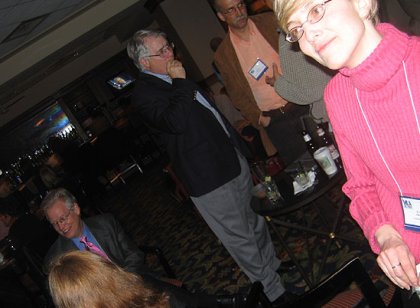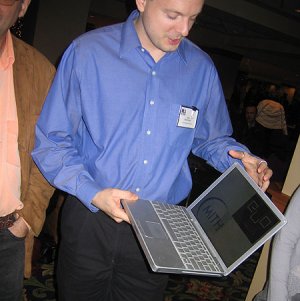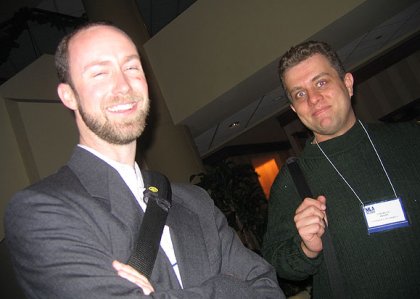![]() “Fibonacci’s Daughter” by M.D. Coverley (a pen name for Marjorie C. Luesebrink), published originally in New River in 2000, is a narrative and architectural puzzle. The main character, Annabelle Thompson, is the daughter of gamblers and a new-age opportunist. She sets up shop in California’s Huntington Beach Mall, where she uses numerology and Fibonacci numbers to peddle insurance policies to high school cheerleaders and football players — insurance against failure, that is. But probability is always chance, and the mystery that lurks here can be resolved in several ways. This piece is part of a larger collection, Fingerprints on Digital Glass, Web-native Fictions. Coverley is also the author of Califia from Eastgate Systems and the recently-released The Book of Going Forth by Day. See the Directory entry for more about this work and author.
“Fibonacci’s Daughter” by M.D. Coverley (a pen name for Marjorie C. Luesebrink), published originally in New River in 2000, is a narrative and architectural puzzle. The main character, Annabelle Thompson, is the daughter of gamblers and a new-age opportunist. She sets up shop in California’s Huntington Beach Mall, where she uses numerology and Fibonacci numbers to peddle insurance policies to high school cheerleaders and football players — insurance against failure, that is. But probability is always chance, and the mystery that lurks here can be resolved in several ways. This piece is part of a larger collection, Fingerprints on Digital Glass, Web-native Fictions. Coverley is also the author of Califia from Eastgate Systems and the recently-released The Book of Going Forth by Day. See the Directory entry for more about this work and author.
Micro-Talespin
![]() James Meehan’s Tale-Spin, created as part of his 1976 dissertation, The Metanovel: Writing Stories by Computer, was the first major project in the area of story generation. Like one of Calvino’s invisible cities, it creates an alternate landscape in which the inhabits live in a manner evocatively different from our own — with all actions the result of plans, the locations of items only learned by convincing someone to tell you, and no one feeling an emotion without knowing it. Like Aesop’s fables, Tale-Spin‘s view of human nature was communicated through the interactions of iconic animals. But unlike the worlds of Calvino or Aesop, Meehan’s world wasn’t simply described — it was made to operate. In fact, its operation, rather than its description, was Meehan’s primary work. (The text describing the world was produced by a bare-bones language generation program, called Mumble, designed primarily to fit in the small amount of memory left on the Yale AI lab’s computer system when Tale-Spin was already running.)
James Meehan’s Tale-Spin, created as part of his 1976 dissertation, The Metanovel: Writing Stories by Computer, was the first major project in the area of story generation. Like one of Calvino’s invisible cities, it creates an alternate landscape in which the inhabits live in a manner evocatively different from our own — with all actions the result of plans, the locations of items only learned by convincing someone to tell you, and no one feeling an emotion without knowing it. Like Aesop’s fables, Tale-Spin‘s view of human nature was communicated through the interactions of iconic animals. But unlike the worlds of Calvino or Aesop, Meehan’s world wasn’t simply described — it was made to operate. In fact, its operation, rather than its description, was Meehan’s primary work. (The text describing the world was produced by a bare-bones language generation program, called Mumble, designed primarily to fit in the small amount of memory left on the Yale AI lab’s computer system when Tale-Spin was already running.)
In 1981 a simplified version of Tale-Spin was published as part of the book Inside Computer Understanding: Five Programs Plus Miniatures. This version, Micro-Talespin, was then translated into Common Lisp (a programming language used in many artificial intelligence projects) by Warren Sack in 1992. It includes the settings for five default stories, simple text output from Micro-Mumble, and also the ability to interact with the simulated world. The ELO website now hosts Sack’s version, which requires that the computer running it have Common Lisp installed. GNU CLISP is an implementation of Common Lisp that works on Unix, MacOS, and Windows machines. To experience Micro-Talespin, start Common Lisp, load Micro-Talespin, and then, at the “?” prompt, type: (micro-talespin-demo *story1*). Next, try starting up with one of the other five stories.
Prince of Persia: The Sands of Time
![]() Jordan Mechner is the writer and designer of groundbreaking cinematic games such as Karateka (1984), Prince of Persia (1989), and The Last Express (1997). His most recent, in collaboration with a small team within Ubisoft’s Montreal studio led by producer Yannis Mallat, is Prince of Persia: The Sands of Time. The gameplay is based on acrobatics, spatial puzzle solving, the manipulation of time, and swordplay. This gameplay connects to the story of the Prince through the Dagger of Time, which Mechner characterizes as “at once a weapon, a receptacle, and a MacGuffin.” The story is told in past tense narration — perhaps for the first time in a video game — with a noir flavor. As one progresses through the game the situation of the narrator’s telling is slowly revealed, pointing to influences such as Thief of Baghdad and, further back, to the traditional frame tale of 1001 Nights.
Jordan Mechner is the writer and designer of groundbreaking cinematic games such as Karateka (1984), Prince of Persia (1989), and The Last Express (1997). His most recent, in collaboration with a small team within Ubisoft’s Montreal studio led by producer Yannis Mallat, is Prince of Persia: The Sands of Time. The gameplay is based on acrobatics, spatial puzzle solving, the manipulation of time, and swordplay. This gameplay connects to the story of the Prince through the Dagger of Time, which Mechner characterizes as “at once a weapon, a receptacle, and a MacGuffin.” The story is told in past tense narration — perhaps for the first time in a video game — with a noir flavor. As one progresses through the game the situation of the narrator’s telling is slowly revealed, pointing to influences such as Thief of Baghdad and, further back, to the traditional frame tale of 1001 Nights.
Shandean Ambles
![]() Laurence Sterne’s Tristram Shandy is the 18th century’s answer to Douglas Adams — irreverent, funny, and surprisingly hypertextual. Shandean Ambles (drafted at the Shandy Hall under Sterne’s imposing nose) parodies this work of nine volumes in nine short steps. Come explore indecent ghosts and sexual harrassment, quills and LCD screens, marbled papers and marble halls where the sauce and the plot never thicken.
Laurence Sterne’s Tristram Shandy is the 18th century’s answer to Douglas Adams — irreverent, funny, and surprisingly hypertextual. Shandean Ambles (drafted at the Shandy Hall under Sterne’s imposing nose) parodies this work of nine volumes in nine short steps. Come explore indecent ghosts and sexual harrassment, quills and LCD screens, marbled papers and marble halls where the sauce and the plot never thicken.
The ELO at MLA, and 2006 Wishes
The electronic literature meetup at the MLA convention was great fun, and a perfect first celebration of the new partnership between the Electronic Literature Organization (ELO) and the Maryland Institute for Technology in the Humanities (MITH).
We hope everyone in the electronic literature community has a great 2006 – and at the end of the next year, we hope to see many of you at the next e-lit MLA meetup, at the MLA convention in Philadelphia.

Jay Clayton, William Warner, Neil Fraistat (director of MITH), and Kari Kraus.

Nick Montfort (ELO vice-president) announces the new partnership between the ELO and MITH.

Rita Raley and Carl Stahmer (associate director of MITH).

Steven Jones and Alan Liu (who serves on the ELO board of directors and is head of the ELO’s PAD project).

Jason Rhody and Charles Tryon.
Not pictured is the photographer, Matthew Kirschenbaum (who serves on ELO’s board of directors and is an associate director of MITH).
ELO and MITH Announce Partnership
At today’s MLA event the Electronic Literature Organization and the Maryland Institute for Technology in the Humanities announced that we have agreed on the principles of a wide-ranging partnership. Plans in the works include research projects, conferences, and a move of the main ELO office to MITH in mid-2006 (while the UCLA ELO node will continue to organize its highly successful events). A joint press release will follow in the new year.
The Breakup Conversation
![]() The Breakup Conversation is a satirical simulation of the conversation at the end of a romantic relationship. The player is expected to perform a breakup over instant messenger, while the computer, playing the role of the soon-to-be-ex, will attempt to guilt and emotionally manipulate the player to give in and fail to break up. The engine includes knowledge of numerous “guilt games†that could take place during a breakup, and some ways of getting through them — for example, the “it’s not you it’s me†ritual, the “why are you doing this to me†blame, the refusals to discuss issues, and other ways in which people panic, reason, plead, lay guilt, and so on. These rituals are treated informally, and meant to be exaggerated and entertaining, rather than psychologically felicitous — they were inspired by sitcoms, personal anecdotes, and popular self-help books on relationships. The Breakup Conversation is a Windows executable program.
The Breakup Conversation is a satirical simulation of the conversation at the end of a romantic relationship. The player is expected to perform a breakup over instant messenger, while the computer, playing the role of the soon-to-be-ex, will attempt to guilt and emotionally manipulate the player to give in and fail to break up. The engine includes knowledge of numerous “guilt games†that could take place during a breakup, and some ways of getting through them — for example, the “it’s not you it’s me†ritual, the “why are you doing this to me†blame, the refusals to discuss issues, and other ways in which people panic, reason, plead, lay guilt, and so on. These rituals are treated informally, and meant to be exaggerated and entertaining, rather than psychologically felicitous — they were inspired by sitcoms, personal anecdotes, and popular self-help books on relationships. The Breakup Conversation is a Windows executable program.
Shifting Stories in “23,040 Bridges”
Adam Cadre’s “23,040 Bridges” provides a combinatoric explosion of different stories, asking the reader to rank how culpable each of five characters is in the death of the main character. Read and rank the characters; Cadre is collecting statistics now on how people assign guilt in the many different versions of the story. The statistics from readers’ judgments will be made available soon.
Digital Media Narrative Job at WPI
Worcester Polytechnic Institute (WPI) is seeking a full-time, tenure-track, Assistant Professor to teach narrative in digital media. We welcome interests in story telling for games and interactive media, digital writing and rhetoric, information design, multimedia authoring and new media studies.
The successful candidate will be a member of WPI’s Department of Humanities and Arts and will join the staff of the university’s Interactive Media and Game Development Program (IMGD) to develop courses and direct undergraduate projects.
Applicants with an MFA are encouraged; Ph.D. is preferred. Deadline is January 16, 2006. More information here: http://www.academiccareers.com/cgi-win/JobSite/sendjob.exe/ACO/?10921
Word Museum
![]() Word Museum was created for the Brown University “Cave” — a room-sized virtual reality display. It asks how one can integrate writing into a scalable 3D space when it seems the scalability and 3D can only serve to render text illegible. Is it possible to write a poem that is readable from many angles, that remains legible even when animated, by using only letters that are still themselves if flipped over or turned upside down?
Word Museum was created for the Brown University “Cave” — a room-sized virtual reality display. It asks how one can integrate writing into a scalable 3D space when it seems the scalability and 3D can only serve to render text illegible. Is it possible to write a poem that is readable from many angles, that remains legible even when animated, by using only letters that are still themselves if flipped over or turned upside down?
